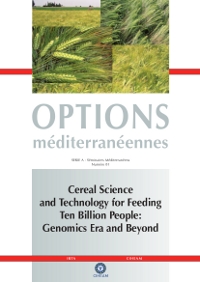| Article précédent | p. 71-73 | Article suivant |
Genetic relationship and structure of Mediterranean durum wheat
Twenty four unlinked SSR markers were used to genotype 192 durum wheat accessions from the Mediterranean region, consisting of 172 landraces and 20 modern widely grown varieties. Clustering and ordination methods provided a picture of the relationships between individuals, and the program Structure assigned genotypes to different groups using a Bayesian approach. Cluster analysis showed that the accessions tended to group according to their geographical origin. All accessions from Turkey, but one, grouped together. Modern Spanish and Italian cultivars clustered together excepting cultivar Simeto, which clustered with a group of Italian landraces. Population was structured in three clusters: one formed by landraces from the Middle East, Egypt and the Balkan Peninsula, another formed by landraces from the western Mediterranean countries and a third one consisting in all modern cultivars, excepting Simeto.
- [ Afficher ]
- [ Télécharger ]
- [ Exporter la citation ]
Vous pouvez télécharger la citation au format :
- [ Imprimer ]
-
Mots-clés
BLE DUR, MARQUEUR GENETIQUE, REGION MEDITERRANEENNE, STRUCTURE GENETIQUE, TRITICUM DURUM, VARIETECiter cet article
Moragues M., Royo C., Sorrells M.E. Genetic relationship and structure of Mediterranean durum wheat. In : Molina-Cano J.L. (ed.), Christou P. (ed.), Graner A. (ed.), Hammer K. (ed.), Jouve N. (ed.), Keller B. (ed.), Lasa J.M. (ed.), Powell W. (ed.), Royo C. (ed.), Shewry P. (ed.), Stanca A.M. (ed.). Cereal science and technology for feeding ten billion people: genomics era and beyond. Zaragoza : CIHEAM / IRTA, 2008. p. 71-73. (Options Méditerranéennes : Série A. Séminaires Méditerranéens; n. 81). Meeting of the Eucarpia Cereal Section, 2006/11/13-17, Lleida (Spain). http://om.ciheam.org/om/pdf/a81/00800807.pdf



